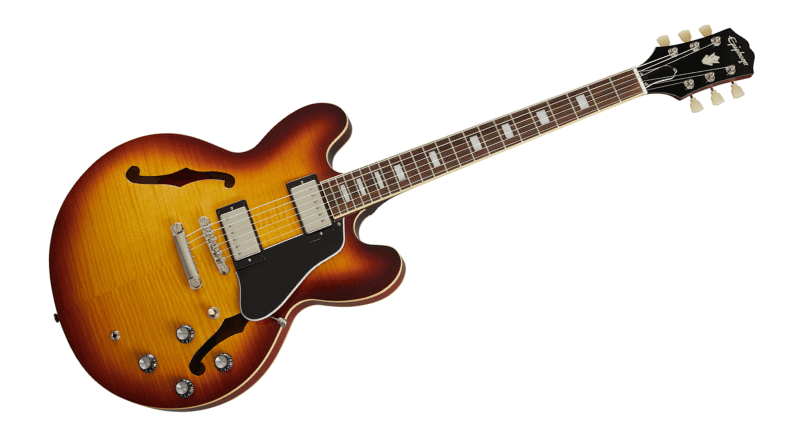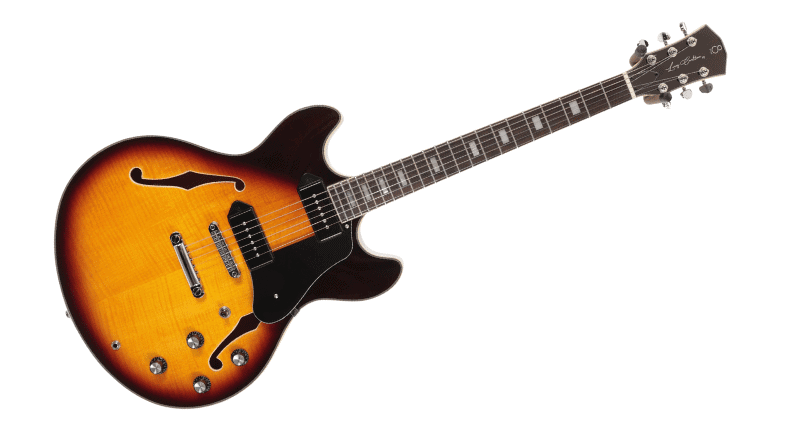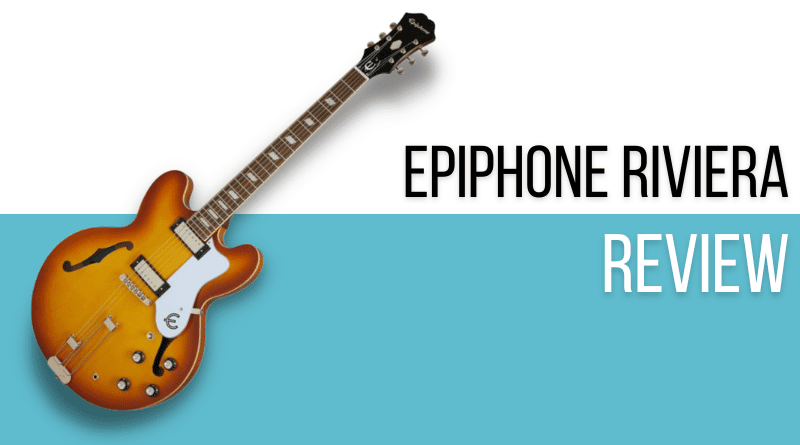Epiphone has enjoyed a truly incredible reputational rise over the last 5 years or so. They had been all but written off as low quality Gibson copies with little going for them other than price. However, particularly since the release of their “Inspired By” range, every model in their lineup has seen marked improvements in quality – case in point, the Epiphone Riviera.
For obvious reasons, the Riviera wasn’t included in the Inspired By range. If you’re not familiar, this is a model that was never made by Gibson. It was in fact, Epiphone’s answer to the ES-335 in the time before Ephiphone became a Gibson brand.
Today’s Riviera stands out as a true workhorse. An affordable option for those who love the ES-335, but perhaps aren’t able to stretch to over $3500 for their guitars. We actually named the Epiphone Riviera as our Top Pick in our roundup of the best ES-335 alternatives, and as you read further into this piece you’ll quickly learn why.
In this KillerGuitarRigs Review, we’ll be taking an in depth look at the Riviera to find out why it’s such a great alternative to the ES-335. We’ll be looking at build quality, tones, and overall performance – keep on reading if you’re in the market for a 335 style guitar!
Read more about our review process.
Contents
Epiphone Riviera Review: Who Is This For?
The Epiphone Riviera is a great guitar for a wide range of players. At around $700 MSRP, it’s not priced with novices in mind, but it’s still forgiving enough for newer guitarists looking to start out on a higher end model.
We will point out, however, that the large body size of the Riviera might well limit this model to larger players, as younger or smaller players may struggle to comfortably hold it.
Appearance / Features / Controls
There are 2 color options available for the Epiphone Riviera; Royal Tan and Sparkling Burgundy. Our test model came in the Royal Tan finish, which looked absolutely outstanding. It had honey burst-like appearance, with plenty of that natural maple grain peeking through the lacquer.
As briefly mentioned, the Riviera was Epiphone’s answer to the ES-335 when it was originally released in 1962, so of course, it borrows heavily from the Gibson’s design and construction. It’s a semi hollow bodied guitar, made with layered maple on the top, back and sides, and of course, a maple center block.
The neck was made with mahogany, and was carved into a rounded C shape that sits somewhere between the vintage ‘50s profiles and the ‘60s SlimTaper in terms of girth. Sitting atop the neck was a laurel fretboard; while we have hit or miss luck with Epiphone laurel boards in terms of aesthetics and feel, we are pleased to report that the board on this Riviera was excellent. Not only was the fretboard great, but the fretwork was also superb.
One of the coolest things about the Riviera is how despite being heavily influenced by the ES-335, it still has a style all of its own. Take for example the Frequensator tailpiece, something not found on the Gibson. This tailpiece is designed to lengthen the bass strings and give the guitar an overall deeper response.
The other major difference is the use of mini humbuckers. In theory they work the same way as full size humbuckers, and offer a tone more like a P90, but still retain the noise canceling effect. Not only do they offer a different vibe tonally, but visually, they look unlike anything else.
As for the rest of the electronics, it came with high end CTS pots, something that has become commonplace on Epiphone guitars, but is still a huge plus point for them.
It came with vintage Kluson style Epiphone Deluxe tuners, and a GraphTech Tusq nut, which makes a huge difference in terms of tone and playability vs plastic. For easy intonation, it had a Tune-O-Matic bridge, too.
Performance / Sound
Compared to some of the other full size semi hollows on the market, the Riviera was pretty lightweight at just 7lb 6oz. This made holding it for extended periods a pretty comfortable affair – something gigging musicians will definitely appreciate.
The playability was absolutely superb. Despite the glossy neck finish, it was still slick, and surprisingly fast. We found it to be very comfortable, and the profile really hit a sweet spot.
The fretwork was fantastic, too. Everything was so well finished you’d think it would have been PLEKd. Leveling was on point, the edges were smooth, and the crowns had a glassy finish that you don’t often find at this price point. Overall, excellent work from Epiphone on this neck and fretboard.
Tonally it had a fantastic balance, and could handly a bit of every style with ease. Blues? Check! Rock? Check! Jazz? Check! Metal? Almost… Ultimately, the mini humbuckers were able to bark like a P90, and were still able to clean up on demand.
They delivered big in terms of attack, with superb sharpness and a lightning fast response. To listen to, there’s no way you’d ever believe that this was a sub $1000 guitar with stock everything.
The CTS pots delivered a satisfying sweep, which really allowed us to dial in a ton of great tones using the volume and tone knobs, too. We found that the warmth and resonance were really fantastic, and thanks to the big hunk of maple running down the middle, it offered fantastic sustain, too.
Other Guitars to Consider
The Epiphone Riviera is a true icon, and today’s version still lives up to the reputation of the original. If you’re looking for an attainably priced alternative to the Gibson ES-335, they don’t come much better in all honesty. Having said that, there are still some other options to consider before making your decision. We’ve highlighted a couple of our favorites below.
Epiphone ES-335

If it’s price that’s keeping you from buying a Gibson ES-335, then, good thing there’s also the Epiphone ES-335. It’s incredibly similar to the Gibson in so many ways, but of course the most striking difference is the use of a poly finish on the Epi vs the nitro on the Gibson. Regardless, it gets you 75% of the way there at about 1/6th of the cost. It delivers great semi hollow tones, looks fantastic, and is available in a wide range of gorgeous finishes.
Sire Larry Carlton H7V

The Sire Larry Carlton H7V is something of an underdog choice, but it’s still one we’d gladly recommend. It nails the look, with the classic double cutaway, and comes with a gorgeous flamed top. Helping it to stand out from the Gibson, it’s fitted with a pair of raucous P90 pickups that go from bell like clean jazz tones through to throaty rock and roll faster than you can say gain knob. It’s a well made guitar, it offers superb playability, and is definitely worthy of consideration.
Final Thoughts on the Epiphone Riviera
The Epiphone Riviera was a real joy to play during this test. From the wonderful neck, to those amazing mini humbucker pickups, it delivered so much more than its price point would have you believe it’s capable of. The design is a true classic, and if you’re really looking to stand out in a sea of ES-335s and the associated clones, this is a great way to let people know that you know what you’re talking about.


